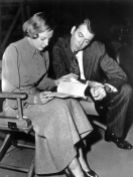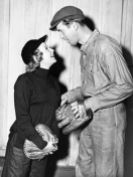
“I have big teeth. I lisp. My eyes disappear when I smile. My voice is funny. I don’t sing like Judy Garland. I don’t dance like Cyd Charisse. But women identify with me. And while men desire Cyd Charisse, they’d take me home to meet Mom.” –June Allyson
MGM was one of the top studios that was well known for its musical output. Among its many glamorous stars was June Allyson; however, rather than being glamorized as a goddess, she maintained a strong girl-next-door throughout her heyday.
Allyson was born Eleanor “Ella” Geisman in the Bronx, New York City, to Robert and Clara Geisman. When Allyson was six months old, her father struggled with alcoholism and abandoned the family–which included both Allyson, and her two-year-old brother, Henry. As a result, Clara worked several jobs such as carrying out the roles of a telephone operator and cashier in order to support her family. Unfortunately, work caused her to be away from her children quite often, leading to the two children being raised mostly by grandparents and other relatives.
Tragedy struck when a tree limb fell on Allyson at the age of eight. She had been riding her tricycle with her pet terrier along for the ride when the limb fell. Allyson suffered a fractured skull and broken back, while her dog was killed. Doctors said that Allyson would never walk again and would have to wear a heavy steel brace from her neck to her hips for four years. Fortunately, Allyson regained the ability to walk, first relying upon a wheelchair, then crutches, followed by braces.
As she worked through her injuries, her favorite form of escape from pain and poverty was the cinema. There, she fell in love with the films of Fred Astaire and Ginger Rogers to the point of memorizing several of Rogers’ routines. She would also escape the harsh realities of her childhood throughout her career by covering up her social status prior to achieving fame and coming up with a fictitious name of a small town that she would deem her birthplace instead.

Later, Allyson’s mother remarried and the family was reunited. They were financially on track again to the point of Allyson even being able to enroll at the Ned Wayburn Dancing Academy, where she started to partake in dance competitions under the name of Elaine Peters. Things took a turn for the worse once more when her stepfather passed away. Allyson left high school after finishing just over two years and started to look for work as a dancer.
Allyson secured her first position as a tap dancer for the Lido Club in Montreal, Canada. Afterwards, she moved back to New York and found work acting in short subject films for Educational Pictures, which operated outside a studio in Queens. Allyson also tried to find work in modeling but was unsuccessful.
A key turning point in Allyson’s career occurred when Educational Pictures cast her in a series of musical comedy shorts. The shorts showed off her on-screen charm and dancing abilities, including titles such as Swing for Sale (1937), Pixilated (1937), Ups and Downs (1937), Dime a Dance (1938), Dates and Nuts (1938) and Sing for Sweetie (1938).
Once Educational Pictures closed its doors, Allyson continued acting at Vitaphone in Brooklyn, often working alongside dancer Hal Le Roy. While also acting at Vitaphone, Allyson was part of the chorus line at the Copacabana Club. She would soon find work in a Broadway show called Sing Out the News in 1938 as June Allyson.
Continuing to work for the stage, she would also appear in the Kern-Hammerstein musical Very Warm for May. Once Vitaphone closed, she pursued a stage career further with roles in Rodgers and Hart’s Higher and Higher and Cole Porter‘s Panama Hattie. Allyson worked as Betty Hutton’s understudy in Panama Hattie and had five performances in the spotlight when Hutton contracted measles. Luckily, Broadway director George Abbott was in attendance on one of her nights and offered her one of the lead roles in his production of Best Foot Forward in 1941.
After a successful run of performances in the stage version of Best Foot Forward, Allyson was slated to appear in the 1943 film version. However, when she arrived in Hollywood, the film had not yet started production. Rather than have her wait, MGM immediately placed her on the payroll by having her appear in a bit part in Girl Crazy (1942) during which she briefly antagonizes Mickey Rooney’s character. Once filming for Best Foot Forward (1943) was completed, Allyson received positive reviews but was still intended to be dropped by the studio. Producer Arthur Freed, however, argued that the be placed under contract and so she remained in MGM’s employ. By the time she appeared in Thousands Cheer (1943), the studio was building her up as a new starlet and overnight sensation as an ingenue, in addition to taking a year off of her real age.
Allyson’s breakthrough role was in Two Girls and a Sailor (1944) alongside Van Johnson. This opened the door to additional musical roles including Meet the People (1944) and Her Highness and the Bellboy (1945). She was well on her way to stardom by the time she appeared in Good News (1947) and already one of the studio’s top actresses when playing Jo March in Little Women (1949). After a string of movie successes and, later, flops, Allyson parted with MGM in 1953.
Though the studio sent Allyson and Johnson on official dates to drum up publicity, Allyson was actually being courted by Dick Powell. Though studio head Louis B. Mayer was opposed to their relationship, Allyson asked him to give her away at their wedding. The couple had two children–much to the delight of Allyson, who was told that her childhood accident would prevent her from having children. Their daughter Pamela was adopted in 1948, while Richard Jr. was born in 1950. Though they divorced in 1961, they reconciled and remarried in 1963.
Allyson found work at other studios, often being cast as the wife of Jimmy Stewart‘s characters, such as in The Glenn Miller Story (1954) for Universal, Strategic Air Command (1955) for Paramount, and more. She also appeared in musical remakes of films, such as The Opposite Sex (1956)–a remake of The Women (1939)–and You Can’t Run Away From It (1956)–a remake of It Happened One Night (1934).
Allyson would also appear on television, hosting her own show from 1959 to 1960. In other cases, she made guests appearances on other shows, including her husband’s–Dick Powell’s Zane Grey Theater. Throughout the 1970s, she would continue to appear on television and also work on the Broadway stage in Forty Carats.
After Powell’s passing, Allyson dedicated her time to charities on his behalf, focusing upon the importance of research in urological and gynecological diseases in seniors. She established the June Allyson Foundation for Public Awareness and Medical Research. In 1996, Allyson became the first recipient of the Harvey Award, presented by the James M. Stewart Museum Foundation, for her positive contributions to the world of entertainment. The American Urogynecologic Society established the June Allyson Foundation in 1998 with a grant from Kimberly-Clark.
Allyson passed away on July 8, 2006, at age 88.
Today, there are few tribute to Allyson. Since the MGM auctions and Debbie Reynolds’s Profiles in History auctions, some pieces that Allyson wore during her career have come up on auction.

As for a physical tribute, in the Bronx, her former high school–Theodore Roosevelt High School–is now the Bronx School of Business. The building is located at 240 E 172nd St in the Bronx, New York.
Allyson is best remembered for her musical filmography in addition to the philanthropic work to which she dedicated herself in her later years. Allyson is honored as one of TCM’s Summer Under the Stars celebrants on August 28, 2019.
This post is part of “The 2019 TCM Summer Under the Stars Blogathon.” The Blogathon is a collaboration between Journeys in Classic Film and Musings of a Classic Film Addict. To access more information and read accompanying posts, please click on the following picture:
















































Pingback: Joan Blondell | Hometowns to Hollywood
Pingback: Classics for Comfort | Hometowns to Hollywood